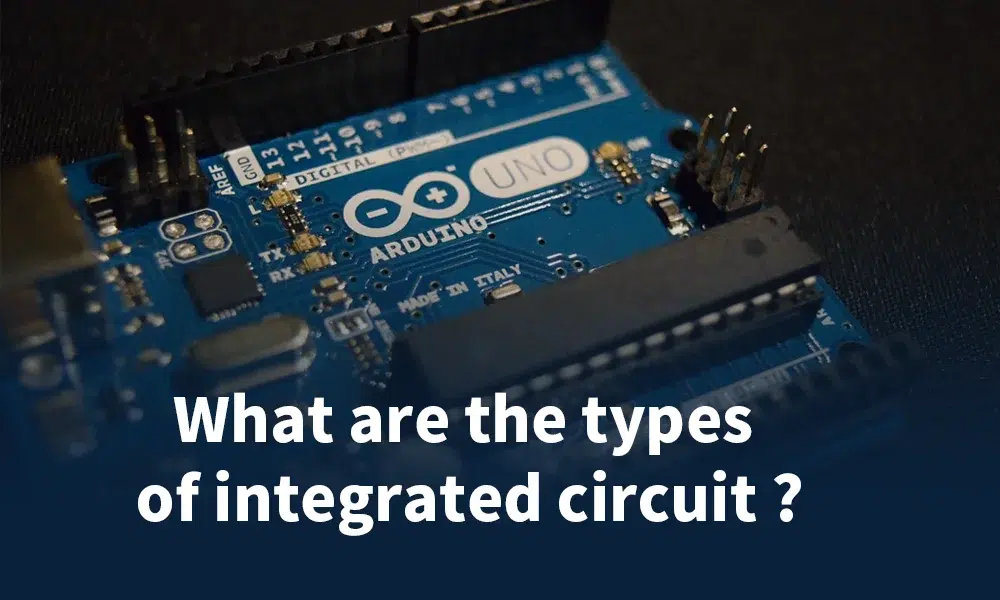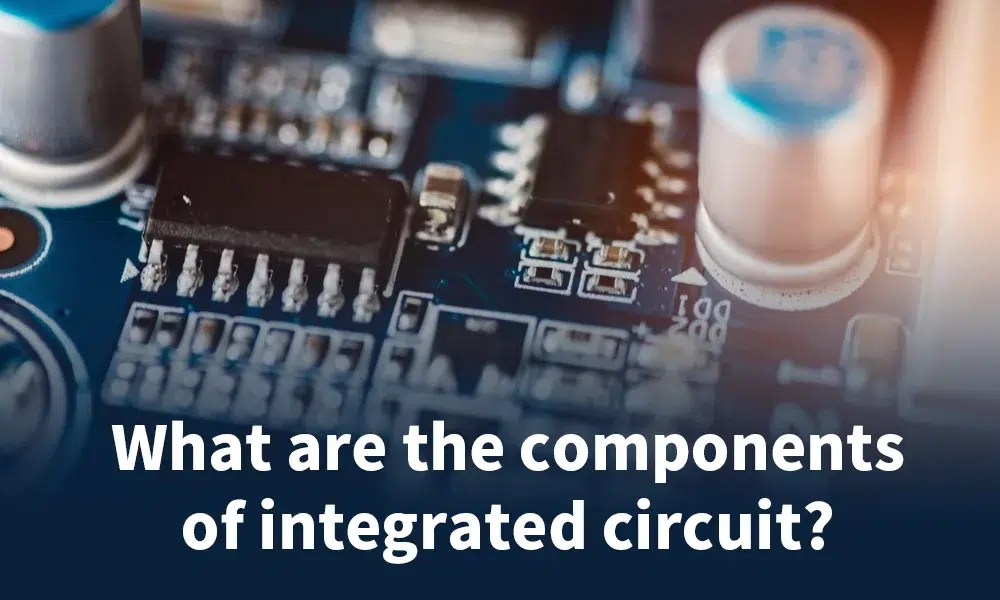Integrated Circuits (ICs) represent a cornerstone of modern electronics, revolutionizing the way electronic devices are designed and manufactured. These circuits, often referred to as microchips or simply chips, are tiny electronic devices made of semiconductor materials, primarily silicon. They encapsulate multiple electronic components and functionalities onto a single chip.
What is an integrated circuit?
An Integrated Circuit (IC) is a miniature electronic circuit that combines multiple electronic components—such as resistors, capacitors, transistors, and diodes—onto a single semiconductor chip. It revolutionized the electronics industry by drastically reducing the size, cost, and power consumption of electronic devices compared to their discrete component counterparts.

What are the types of integrated circuit ?
There are three main types of Integrated Circuits (ICs): Analog ICs, Digital ICs, and Mixed-Signal ICs.
1. Analog Integrated Circuits (Analog ICs):
Function: Process continuous signals.
Applications: Amplifiers, voltage regulators, and operational amplifiers fall under this category. They’re commonly used in devices like amplifiers, current controllers, and electronics related to audio and visuals.
2. Digital Integrated Circuits (Digital ICs):
Function: Process digital signals, operating based on binary values.
Applications: Microprocessors, memory chips, and digital signal processors are part of this category. They work with digital signals and perform logical operations like AND, OR, NOT in computers, mobile phones, and various electronic devices.
3. Mixed-Signal Integrated Circuits (Mixed-Signal ICs):
Function: Combine both analog and digital functionalities.
Applications: Data converters, sensor interfaces, and smart medical devices fall into this category. They integrate analog and digital features to process and transmit both digital and analog data in complex electronic systems.
These IC types offer diversity in signal and data processing, providing a foundation for developing various electronic devices ranging from consumer products to industrial and medical applications.
What are the advantages and disadvantages of ICs?
Advantages:
Compactness: Multiple components in a small space.
Reliability: Fewer physical connections reduce chances of failure.
Cost Efficiency: Economical mass production.
Performance: Enhanced speed and efficiency.
Disadvantages:
Complexity in Manufacturing: Precise fabrication processes are required.
Vulnerability to Damage: Damage to one part can affect the entire IC.
Limitation in Customization: Not as easily customizable as discrete components.
What are the characteristics of integrated circuit?
Size: Extremely compact, with components etched onto a semiconductor chip.
Complexity: Can incorporate thousands to billions of components.
Reliability: Reduced failure rates due to fewer external connections.
Speed: Operate at high speeds due to reduced internal distances.
Power Consumption: Generally lower compared to discrete circuits.

What are the components of integrated circuit?
Integrated Circuits (ICs) consist of various components that are integrated onto a semiconductor chip. Here are the primary components within an IC:
1. Transistor:
Transistors are fundamental electronic components used for switching or amplifying electronic signals within an IC.
2. Diode:
Diodes permit the flow of current in only one direction. They are used to control current flow and protect other components from reverse voltages within ICs.
3. Resistor:
Resistors control the flow of current within a circuit. In ICs, resistors might be integrated to regulate or reduce voltage and current within the circuit.
4. Capacitor:
Capacitors store electrical energy within a circuit. In ICs, they can be used for signal filtering or providing stable power to other components.
5. Interconnections:
Metal or polysilicon pathways connect the integrated components within an IC, enabling the flow of current and signals through the circuit.
6. Logic Gates:
These are basic elements in digital circuits that perform logical operations such as AND, OR, NOT. They process digital information within the IC.
7. Memory Cells:
In ICs designed for memory functions, memory cells are utilized to store data. These cells function as RAM, ROM, or flash memory in various IC applications.
These components are integrated onto a small semiconductor chip to create ICs that can perform multiple functions within modern electronic devices.
What is the difference between integrated and discrete circuits?
Integrated Circuits combine multiple components onto a single chip, reducing size and complexity. Discrete Circuits use individual components connected on a board, offering flexibility but at the cost of increased space and complexity.
How integrated circuits are made?
Design: Creation of the circuit layout using specialized software.
Mask Creation: The design is transferred onto masks used for semiconductor lithography.
Wafer Fabrication: Etching the circuit pattern onto a silicon wafer through various processes like photolithography and doping.
Assembly and Testing: Multiple dies are cut from the wafer, packaged, and tested for functionality.
What is application of integration circuit?
ICs find applications in almost every electronic device:
Consumer Electronics: Smartphones, computers, TVs, and gaming consoles.
Automotive Industry: Control systems, engine management, and entertainment.
Healthcare: Medical devices, monitoring equipment, and imaging systems.
Industrial Equipment: Control systems, robotics, and sensors.
How to design IC circuits?
Specification and Requirements: Define the circuit’s purpose and functionalities.
Schematic Design: Create a schematic diagram using specialized software.
Layout Design: Translate the schematic into a physical layout considering space and connectivity.
Simulation and Testing: Simulate the circuit’s performance and functionality.
Fabrication: Follow fabrication processes adhering to industry standards.

list Integrated Circuits manufacturers in the world
1. Intel Corporation: Known for CPUs and various semiconductor products.
2. Samsung Electronics: Produces a wide range of ICs for consumer electronics and memory chips.
Taiwan Semiconductor 3. Manufacturing Company (TSMC): Leading semiconductor foundry providing manufacturing services for numerous IC designs.
4. NVIDIA Corporation: Specializes in GPUs, chipsets, and AI-focused ICs.
5. Broadcom Inc.: Produces ICs for wireless communications, networking, and various technologies.
6. Qualcomm Incorporated: Renowned for mobile chipsets, wireless technologies, and processors.
7. Texas Instruments: Offers a broad portfolio of ICs, including analog, embedded processors, and digital signal processors.
8. SK Hynix: Major player in memory chips, including DRAM and NAND flash.
9. Micron Technology: Known for memory and storage solutions, including DRAM and NAND flash.
10. Advanced Micro Devices (AMD): Produces CPUs, GPUs, and other semiconductor products.
11. Infineon Technologies: Focuses on power semiconductors, automotive ICs, and security solutions.
12. STMicroelectronics: Offers a wide range of ICs, including sensors, microcontrollers, and power management.
13. ON Semiconductor: Specializes in power management, sensors, and imaging ICs.
14. Analog Devices: Renowned for analog and mixed-signal ICs used in various applications.
15. NXP Semiconductors: Focuses on automotive, security, and IoT-related ICs.
Conclusion
Integrated Circuits have transformed the world of electronics, enabling the creation of powerful, compact, and efficient devices that have become indispensable in our daily lives. Their evolution continues to drive technological innovation across various industries, shaping a future where electronics are more capable, efficient, and accessible.
An Integrated Circuit (IC) is a miniature electronic circuit that combines multiple electronic components—such as resistors, capacitors, transistors, and diodes—onto a single semiconductor chip.
Analog Integrated Circuits (Analog ICs)
Digital Integrated Circuits (Digital ICs)
Mixed-Signal Integrated Circuits (Mixed-Signal ICs)
Transistor
Diode
Resistor
Capacitor
Interconnections
Logic Gates
Memory Cells










